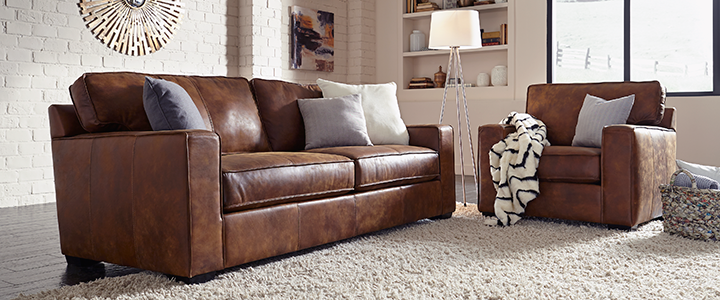Leather Glossary
LEATHER GLOSSARY
- Aniline: A process of colouring the hide in a drum that penetrates the leathers throughout using transparent aniline dyes.
- Bi Cast: Application of polyurethane surface coating on a split or top grain leather.
- Base Coat: Colour that is applied to the crust colour to achieve the final colour of the protected aniline.
- Buffed or Polished: Top grain leather that has been mechanically sanded to remove surface imperfections.
- Chromium Tanning: Upholstery leather which has been tanned with chromium salts. This method makes the hide flexible and supple.
- Crocking: The rubbing off of surface substances or colour onto another material. Commonly referred to as dye transfer.
- Crust: The raw hide that has been tanned and dyed, but has not yet been completely finished.
- Colour Fastness: Colour Fastness to light is a measure of how permanent a colour is on leather after exposure to
- Corrected Grain: Outside skin is processed and sandpapered to minimize flaws and then pigmented and embossed.
- Distressed: Process used to create an effect resembling a worn look or an aged appearance. Techniques used to create this effect include tumbling the hides with abrasive items in order to scratch the leather’s surface.
- Drum Dyed: A dyeing process in which leather is immersed in dyes and tumbled in a rotating drum allowing maximum penetration.
- Embossing: A process that alters the natural grain of the leather by using etching, engraving or electrotyped plates to create a very uniform grain pattern.
- Fat Liquoring: Process of replacing oils that have been depleted from the hide during the tanning process.
- Fat Wrinkle: Natural wrinkles in the leather’s grain that are unique to each hide. Normally visible only in the full grain leathers. Common around the neck and shoulder areas of the hide.
- Finishing: Any post-tanning treatment such as dyeing, rolling, spraying, antiquing, waxing, buffing, embossing, glazing.
- Full Grain: Leather in which the hair has only been removed while the grain remains in it’s original state.
- Glazed Finish: The leather surface is polished to high luster.
- Gloss Finish: Higher shine/sheen level finish usually with the enhanced texture added.
- Grain: Pattern characterized by the pores that are unique to the animal. They are visible on the outer surface of a hide after the hair has been removed.
- Hand: A term used to describe the softness or feel of leather when touched with your hand.
- Hides: Skins from cattle for leather furniture.
- Leather: All hides and skins that are tanned.
- Liming: The chemical process of removing the hair from the raw hide.
- Matte Finish: Low gloss finish usually with enhanced texture added.
- Milling/Tumbling: A process in which hides are tumbled in rotating drum to soften the hand or enhance the grain.
- Naked Leather: Tanned, aniline dyed leather that has no protective top coat. Commonly referred to as pure aniline.
- Natural Grain: Leather which the grain has not been altered in any way. The natural appearance of the grain is predominant showing visibly healed scares, fat wrinkles, insect bites, etc.
- Nubuck: Top grain, aniline dyed leather that has been buffed to create a “suede like” nap effect.
- Patina: A luster that develops with time and use.
- Pigmented: Leather surface that is coated with colour pigments.
- Pull-up: When leather is pulled, the oils or the waxes in the leather cause the colour to dissipate and become lighter.
- Pure Aniline: A leather that is drum dyed but has little or no protected top coating to prevent it from cracking, staining or crocking.
- Sauvage: A two toned effect utilizing two different colours of dye which adds depth and character to the leather.
- Semi Aniline: Leather that has been aniline dyed throughout then protected by a clear or pigmented finish coating thus creating a more consistent colour than pure aniline leathers. Natural markings may
- be visible with some semi-aniline leathers.
- Split: The middle or bottom layer of the hide. Split leathers are used in areas that are not under any stress, as backs or sides of sofa. Embossed to create a very uniform grain pattern.
- Split Grain: The underneath layer of a hide which has been “split” off when the top grain is separated. If finished, the split is heavily embossed and surface treated.
- Suede: Leather produced from the underneath layer/lower split of a hide processing a velvet-like nap effect. Suede does not have same durable characteristics as a top grain leathers.
- Tanning: The process of turning raw hides into leather.
- Top Grain: Top part of the skin or hide. The grain may be either full grain or embossed grain. The top grain of the hide is stronger and more flexible.
- Wet Blue: Refers to the “blue” colour and appearance created by the chromium tanning process.
|

